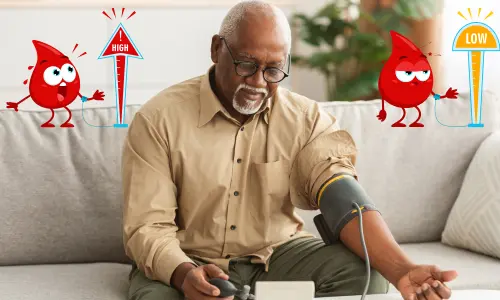Blood Pressure
Blood pressure is the force of blood pushing against the walls of your arteries as your heart pumps it around your body. It’s measured in two numbers: A normal blood pressure reading is around 120/80 mmHg. If your numbers are consistently higher or lower than this, it could indicate a problem. What is High Blood Pressure (Hypertension)? High blood pressure, or hypertension, occurs when the force of blood against your artery walls is too high. It’s often called a “silent killer” because it usually has no symptoms but can lead to serious health problems like heart disease, stroke, and kidney damage. What is Low Blood Pressure (Hypotension)? Low blood pressure, or hypotension, happens when the force of blood against your artery walls is too low. While it’s less common than high blood pressure, it can cause dizziness, fainting, and fatigue. Low Blood Pressure Range: Below 90/60 mmHg. How to Control High Blood Pressure If you have high blood pressure, here are some steps to help manage it: Take Medications: If your doctor prescribes medication, take it as directed. How to Control Low Blood Pressure If you have low blood pressure, here are some tips to manage it: Stand Up Slowly: To prevent dizziness, take your time when moving from sitting to standing. Exercises for High Blood Pressure If you have high blood pressure, the best exercises are those that are moderate and consistent. These help strengthen your heart and improve blood flow without overstraining your body. Examples include: Avoid: High-intensity exercises like sprinting or heavy weightlifting, as they can temporarily spike blood pressure. Exercises for Low Blood Pressure If you have low blood pressure, the goal is to improve blood circulation and prevent sudden drops in blood pressure. Focus on gentle, low-impact exercises that don’t involve rapid changes in position. Examples include: Avoid: Exercises that involve sudden movements or standing up quickly, as these can cause dizziness or fainting. Using a Digital Blood Pressure Machine A digital blood pressure machine is a simple, easy-to-use device that lets you check your blood pressure at home. Here’s how to use it: Tips for Accurate Readings: If you’re unsure about your readings, consult your doctor. Why a Digital Blood Pressure Machine is Helpful Early Detection: Spotting high or low blood pressure early can prevent serious health issues. Conclusion Whether you’re dealing with high or low blood pressure, managing it is key to living a healthy life. By eating right, staying active, and using a digital blood pressure machine to keep track of your numbers, you can take control of your health. Remember, small changes can make a big difference! If you’re concerned about your blood pressure, always consult your doctor for personalized advice. Stay healthy, stay happy!


